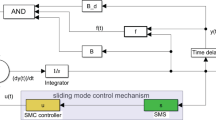Abstract
According to a classical theorem in mathematical physics, a mechanical system is completely defined by its Lagrangian. This property is utilized to design the tracking control of manipulators via a new family of sliding surfaces referred to as ‘sliding Lagrangian surfaces’ and which exhibit some interesting features. They are physically meaningful. They create forces of reaction of low magnitude. They are intimately related to the second variation of the mechanical Lagrangian, in such a manner that one can refine the design by using a neighbouring-optimal control involving linear dynamic and quadratic cost. One can also combine the approach with the variable structure technique to achieve a good robustness with a low chattering phenomenon.
Similar content being viewed by others
References
Craig, J. J.:Introduction to Robotics: Mechanics and Control, Adison-Wesley, 1986.
Dubowsky, S. and Desforges, D. T.: The application of model-reference adaptive control to robot manipulators,ASME J. Dyn. Syst. Meas. Control 101 (1979), 193–200.
Horowitz, R. and Tomizuka, M.: An adaptive control scheme for mechanical manipulators-compensation of nonlinearities and decoupling control,ASME J. Dyn. Syst. Meas. Control 108 (1986), 127–135.
Koivo, A. and Guo, T.: Adaptive linear controller for robotic manipulators,IEEE Trans. Automatic Control 28 (1983), 162–171.
Le, C. S. G. and Chung, M. J.: An adaptive control strategy for mechanical manipulators,IEEE Trans. Automatic Control 29 (1984), 837–840.
Slotine, J. and Li, W.: Adaptive manipulator control: a case study,IEEE Trans. Automatic Control 33 (1988), 995–1003.
Craig, J. J., Hsu, P. and Sastry, S. S.: Adaptive control of mechanical manipulators,Int. J. Robotics Res. 6 (1987), 16–28.
Young, K.-K. D.: Controller design for a manipulator using theory of variable structure systems,IEEE Trans. Systems, Mans Cybernetics 8 (1978), 101–109.
Utkin, VI.: Variable structure systems with sliding modes,IEEE Trans. Automatic Control 22 (1977), 211–222.
Tso, S.-K., Xu, Y. and Shum, H.-Y.: Variable structure model reference adaptive control of robot manipulators,J. Systems Eng. 1(1) (1991), 22–30.
Jumarie, G.: A new approach to control and filtering of mechanical systems by using the estimates of their Lagrangians,J. Optimization Theory and Applications 68(2) (1991), 289–304.
Asada, H. and Slotine, J. J.:Robot Analysis and Control, Wiley, New York, 1986.
Barbaschin, E. A.:Introduction to the Theory of Stability, Wolters-Noordhoff, Groningen, 1970.
Stengeld, R. F.:Stochastic Optimal Control, Wiley, New York, 1986.
Bryson, R. F. and Ho, Y. C.:Applied Optimal Control, Wiley, New York, 1975.
Paul, R.:Robot Manipulators, MIT Press, 1982.
Author information
Authors and Affiliations
Rights and permissions
About this article
Cite this article
Jumarie, G. Tracking control of mechanical systems via sliding Lagrangian. J Intell Robot Syst 13, 181–199 (1995). https://doi.org/10.1007/BF01254851
Received:
Accepted:
Issue Date:
DOI: https://doi.org/10.1007/BF01254851




